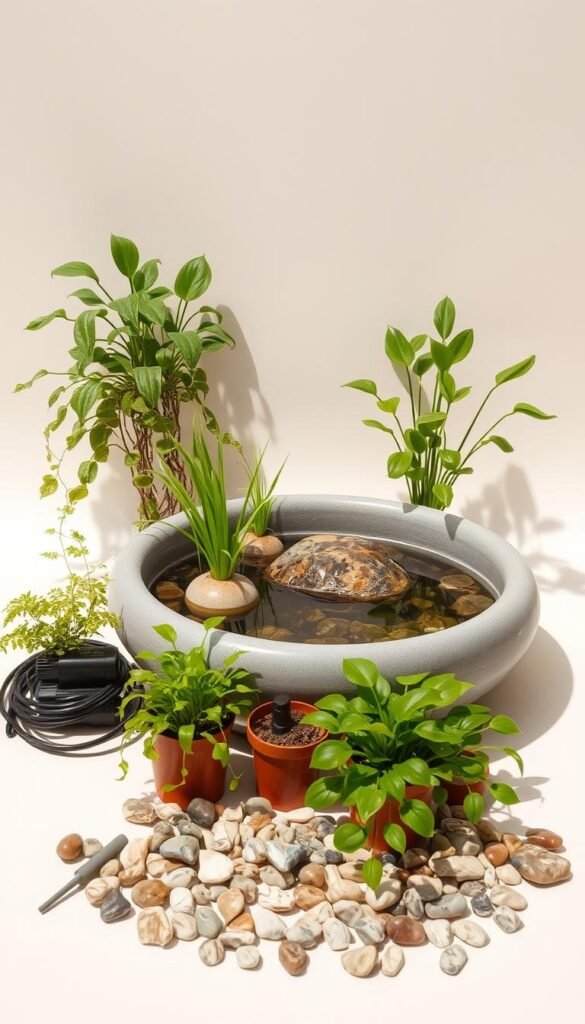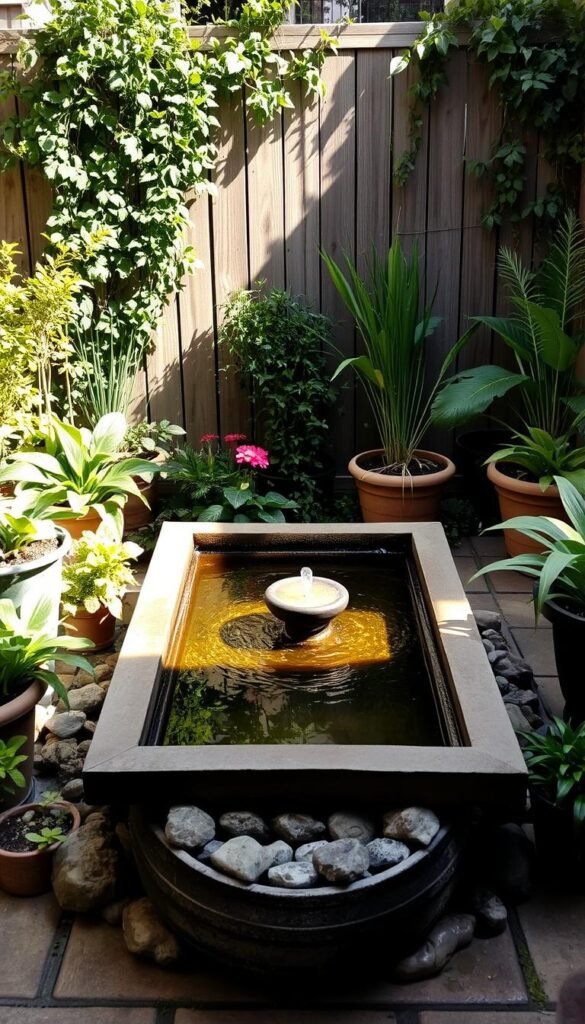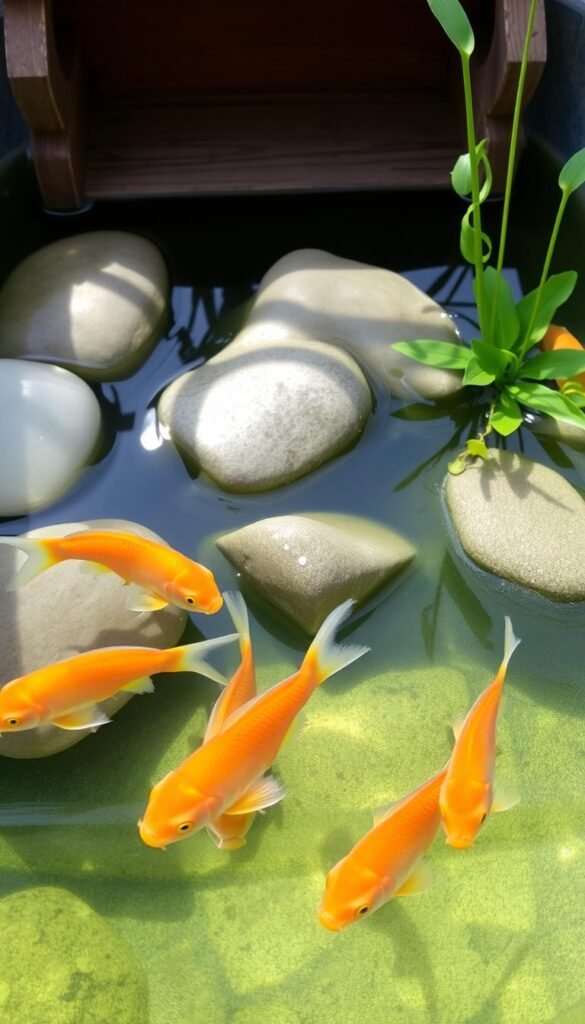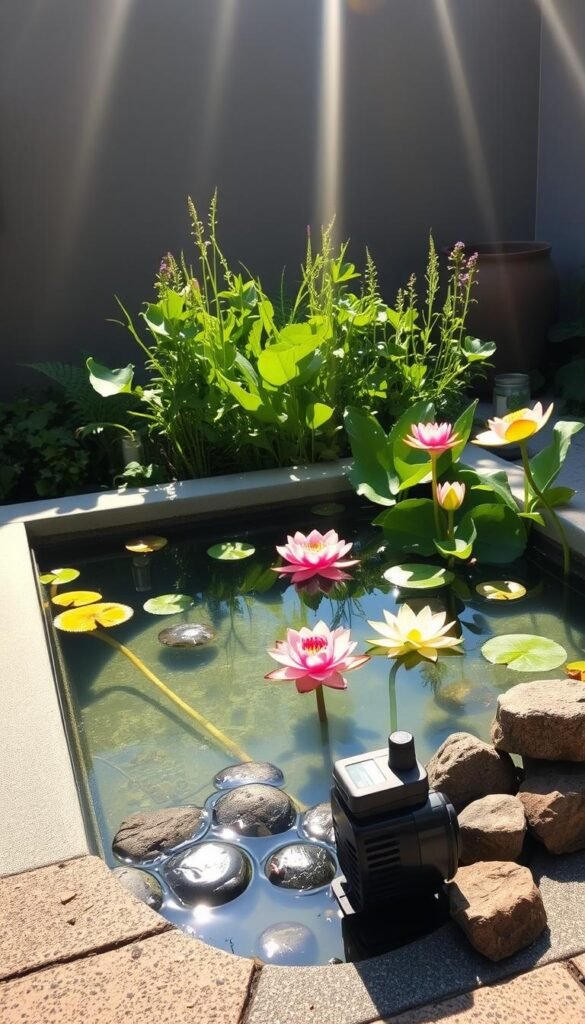Dreaming of a peaceful retreat but short on space? A compact water feature can bring tranquility to your balcony, patio, or even indoors. These charming setups offer the soothing sounds of flowing water without needing a large yard.
Perfect for urban living, these aesthetic additions fit effortlessly into small areas. Whether you’re in an apartment or have a cozy office corner, you can create your own calming oasis.
In this guide, we’ll explore easy setup tips, ideal plants, and low-maintenance care. You’ll discover how simple it is to enjoy nature’s relaxation benefits right at home.
Why Choose a Container Water Garden for Your Patio?
Transforming your outdoor space into a calming retreat is easier than you think. A patio pond brings nature’s serenity right to your doorstep, even in the smallest areas. These compact setups offer both beauty and function, making them ideal for modern living.
The Relaxing Benefits of Mini Ponds
The gentle sound of bubbling water instantly lowers stress levels. Studies from the NIH show that blue spaces—areas with visible water—boost mental well-being. A small fish pond on your deck or balcony creates this effect effortlessly.
Here’s why these features work so well:
- Sound therapy: Flowing water masks urban noise, promoting relaxation.
- Visual appeal: Rippling surfaces and aquatic plants create a dynamic focal point.
- Wildlife attraction: Birds and butterflies often visit, adding life to your space.
Space-Saving Solutions for Any Home
Traditional ponds require yards of space, but a patio pond fits almost anywhere. A 15–30 gallon container is all you need—that’s 90% less area than standard setups. Perfect for renters or apartment dwellers, these portable features won’t damage property.
Popular compact options include:
- 32″ Japanese-style bowls for decks
- 22″ slate-gray containers for tabletops
Looking for more patio gardening ideas? These versatile designs blend seamlessly with other outdoor elements.
Beyond decoration, these mini ecosystems support aquatic plants and small fish. They’re self-contained worlds that thrive with minimal care, proving you don’t need acres to enjoy nature’s perks.
Essential Supplies for Your Mini Pond

Ready to build your own peaceful retreat? Start with the right supplies. A well-equipped water feature ensures clarity, circulation, and longevity. Here’s what you’ll need to create a thriving patio pond.
Choosing the Right Container
Durability matters for constant moisture exposure. Fiberglass resists cracking, while upcycled stock tanks (like galvanized steel) offer rustic charm. Avoid porous materials unless sealed with fish-safe epoxy paint.
Popular options include:
- Fiberglass planters: Lightweight and frost-resistant.
- Upcycled barrels: Eco-friendly but may need lining.
Must-Have Equipment: Pumps and Filters
A pump keeps water moving to prevent stagnation. For a 40-gallon setup, aim for 200+ GPH (gallons per hour). The 210 GPH MagFlo model is a reliable choice.
Filters come in two types:
- Mechanical: Traps debris with sponges or mesh.
- Biological: Uses bacteria to break down waste.
Pair your system with self-watering systems for low-maintenance care.
“Always test DIY containers for leaks before adding plants or fish.”
Quick Checklist:
- Container (fiberglass, sealed metal, or resin)
- Submersible pump (200+ GPH for 40 gallons)
- Tubing and sealant
- Mechanical or biological filter
Step-by-Step Guide to Setting Up Your Patio Pond

Bringing nature’s calm to your outdoor space starts with a simple setup. Whether you’re a beginner or a seasoned gardener, these steps ensure your patio pond thrives from day one.
Prepping Your Container
Start with a thorough clean. Scrub the inside with a 1:1 vinegar-water mix to remove residues. Rinse well—any leftover debris can harm plants or fish.
Positioning matters. Place your feature where it gets 40% sunlight (about 4–6 hours daily). Too much light encourages algae, while too little stunts plant growth.
- Test for leaks: Fill the container halfway and wait 2 hours. Dry spots? Reseal with aquarium-safe silicone.
- Water prep: If adding fish, dechlorinate tap water 24 hours in advance. Use a conditioner like API Stress Coat.
Installing the Water Feature
Choose your pump type. Submersible models (like the Tetra Whisper) hide easily, while external ones are louder but easier to maintain.
“Always secure tubing with stainless-steel clamps—flexible hoses can detach over time.”
Follow these steps for a silent, leak-free system:
- Attach tubing to the pump’s outlet port.
- Run it through the container’s pre-drilled hole or over the rim.
- Plug into a GFCI outlet to prevent electrical hazards.
Troubleshooting tips: If the pump hums loudly, check for debris in the impeller. Unstable shelves? Use a leveling mat under the container.
Best Aquatic Plants for Container Water Gardens

The right plants can turn your small aquatic setup into a thriving ecosystem. They filter water, add vibrant textures, and create habitats for tiny wildlife. Whether you prefer floating greens or rooted bog varieties, each type plays a unique role.
Floating Plants for Natural Filtration
These surface dwellers soak up excess nutrients, starving algae before it blooms. Water hyacinth is a top pick, but trim its fast-growing roots monthly to prevent overgrowth.
Top performers include:
- Water lettuce: Forms a canopy, shading fish and reducing evaporation.
- Fairy moss: A nitrogen sponge that turns vibrant red in sunlight.
- Duckweed: Tiny but mighty—doubles as fish food.
“Cover 30–50% of the surface with floating plants for optimal filtration without blocking light.”
| Plant | Benefits | Care Level |
|---|---|---|
| Water hyacinth | Purifies water, blooms lavender flowers | Moderate (trim roots) |
| Duckweed | Grows rapidly, feeds fish | Easy |
Bog Plants for Texture and Color
Plant these along the edges for vertical interest. Corkscrew rush adds whimsy with spiral stems, while blue iris delivers bold summer blooms.
Try these standout options:
- Sweet flag: Grass-like with a spicy fragrance.
- Blue iris: Thrives in shallow water, attracting pollinators.
Fertilize with aquatic-safe tablets every six weeks. In summer, thin overgrown plants to maintain balance.
Adding Fish to Your Mini Pond: Tips and Tricks

Watching colorful fish glide through your mini pond adds life and movement to your space. These tiny swimmers create a lively ecosystem while keeping mosquito larvae in check. With the right species and care, your water feature becomes a thriving habitat.
Small Fish Species That Thrive in Containers
Choose species suited to limited space. White Cloud Mountain minnows handle temperature swings, while celestial pearl danios dazzle with iridescent spots. Avoid koi—they outgrow small setups fast.
Ideal picks include:
- Guppies: Hardy and prolific, perfect for beginners.
- Endler’s livebearers: Vibrant colors, stay under 1.5 inches.
- Rosy red minnows: Tolerate cooler water.
“A 20-gallon pond comfortably houses 4 adult guppies and 2 snails—balance is key.”
Avoiding Overcrowding
Follow the 1-inch-per-gallon rule. Overstocking stresses fish and clouds the water. Introduce new additions gradually: float their bag for 90 minutes to equalize temperatures.
Warning signs of trouble:
- Fish gasping at the surface (low oxygen)
- Sudden algae blooms (excess waste)
Pair fish with ramshorn snails for natural algae control. For more tips, see our guide to stocking pond fish.
Keeping Your Water Garden Clean and Healthy

A thriving water feature stays beautiful with simple care routines. Focus on two key areas: preventing algae and nurturing beneficial bacteria. With the right approach, your setup will remain crystal clear with minimal effort.
Stop Algae Before It Starts
Algae thrives in sunlight and stagnant water. Combat it with a three-part strategy:
- Shade: Use floating plants like water lettuce to cover 30–50% of the surface.
- Filtration: A 200 GPH pump keeps water moving, discouraging green blooms.
- Barley straw: This natural treatment releases compounds that inhibit algae growth.
For stubborn cases, hydrogen peroxide (3% strength) can spot-treat affected areas. Always test on a small section first.
Harness the Power of Beneficial Bacteria
These microscopic helpers break down fish waste and excess nutrients. LiquidClear and Muck Defense Tablets are top-rated options. Apply monthly in summer and quarterly in winter for best results.
| Product | Best For | Frequency |
|---|---|---|
| API Pond-Zyme | New setups | Weekly for first month |
| Aquascape Beneficial Bacteria | Established systems | Monthly maintenance |
“Replace 20% of the water weekly with dechlorinated water to maintain balance.”
Test water monthly for ammonia (maintenance tips for healthy plants, check our hydroponics guide.
DIY Patio Pond Ideas for the Crafty Gardener
Got a creative streak? Transform everyday items into stunning water features that elevate your outdoor space. These projects blend functionality with personality, giving you a one-of-a-kind garden centerpiece.
Creative Upcycling Projects
Repurpose what you already own for eco-friendly charm. An old wine barrel becomes a rustic pond with a simple liner—just drill overflow holes 2″ below the rim for rainy days.
Other unique conversions:
- Galvanized stock tanks: Farmhouse-chic and durable.
- Vintage bathtubs: Add a claw-footed vintage vibe.
- IBC totes: Cut the top off for a budget pond under $100.
“Always sand sharp edges on upcycled materials to protect fish and plants.”
Personalized Touches That Pop
Make your feature truly yours with these easy upgrades:
- Lighting magic: Submerge LED spotlights or scatter glow pebbles for nighttime allure.
- Water movement: Attach bamboo spouts to pumps for a zen trickle.
- Textured walls: Glue mosaic tiles to the container’s exterior.
For more inspiration, explore these creative pond transformations using pallets and tractor tires.
Remember: The best DIY projects reflect your style while keeping ecosystems healthy. Test all non-toxic materials before introducing wildlife.
Enjoy Your Tranquil Oasis Year-Round
Your patio retreat can thrive in every season with simple adjustments. A water garden brings joy whether it’s snowing or sweltering outside. Just adapt your care routine to keep the ecosystem balanced.
In winter, use a floating de-icer to maintain an open area in the surface. Reduce fish feeding since their metabolism slows. Summer demands shade cloths to protect against scorching heat—add oxygenating plants like hornwort to boost freshness.
Rotate plants seasonally for continuous color. Try water poppies in spring and switch to hardy water hawthorn when temperatures drop. This keeps your setup vibrant all year.
Share your progress! Tag us in photos of your evolving patio paradise. With minimal maintenance, you’ll always have a serene spot to unwind. Your personal haven is just a few steps away—dive in and enjoy!






